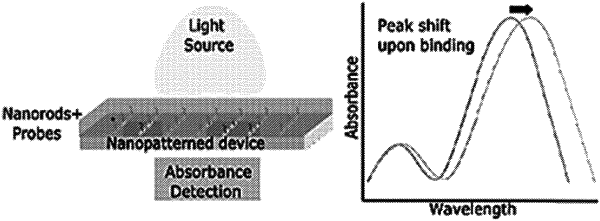| CPC G01N 33/54373 (2013.01) [G01N 21/554 (2013.01); G01N 33/54346 (2013.01); G01N 33/553 (2013.01); B82Y 15/00 (2013.01); B82Y 30/00 (2013.01)] | 19 Claims |

|
1. A plasmon-resonance biosensor comprising:
a plurality of precious metal nanorods, the precious metal nanorods having a long dimension greater than a narrow dimension by a factor of at least 1.5 and a maximum dimension less than one half micron;
the nanorods organized in rows;
the nanorods in the rows are oriented with the long dimension approximately parallel to the rows;
the precious metal nanorods are conjugated with a biological probe material capable of binding to an analyte, the biological probe material, is a protein-nucleic acid (PNA) or a complimentary DNA.
|